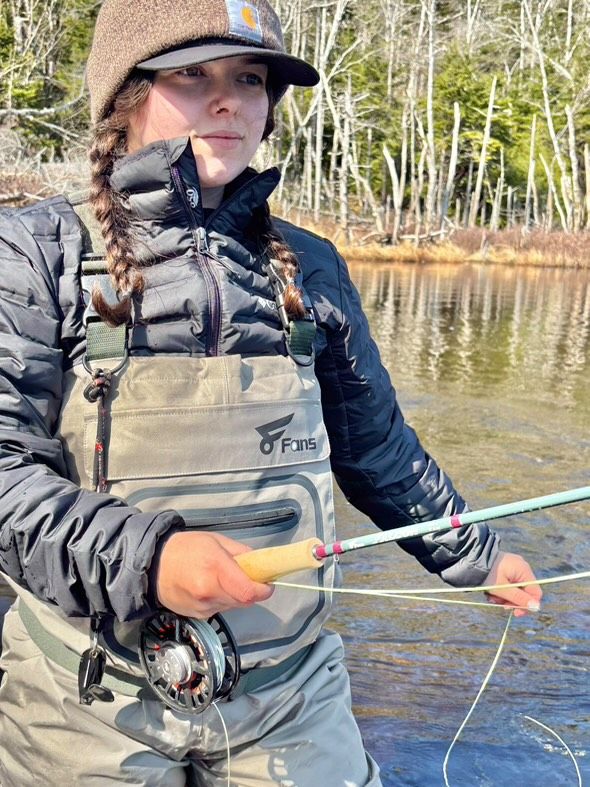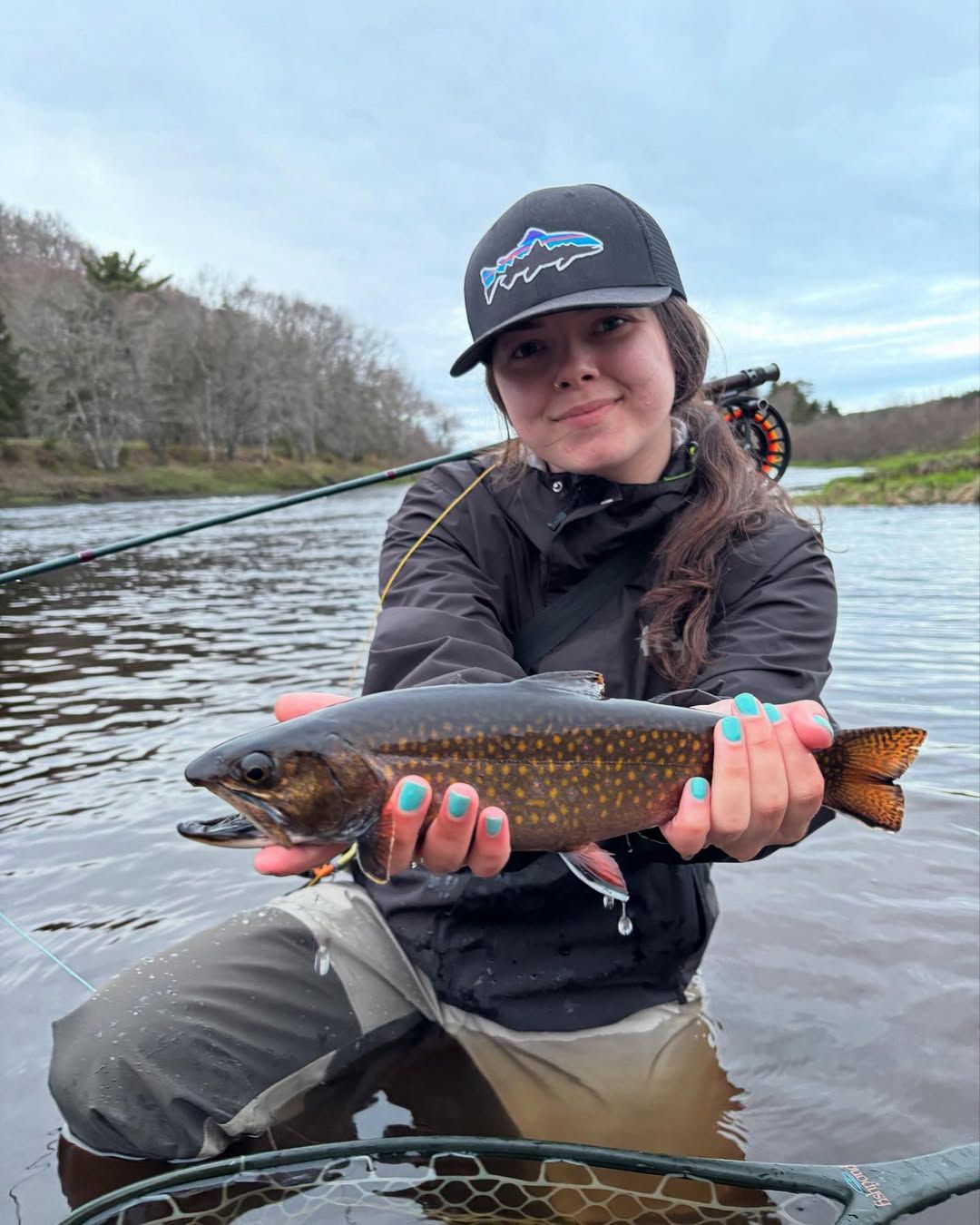
The Woman Behind the Rod: Lane Logue’s Story!
- How did you first get into fly-fishing? What inspired you to start?
My partner inspired me to take on the journey of fly fishing back in 2019, he took me under his wing and taught me everything I know today. Seeing how much thought and effort it took to catch fish on a f ly really influenced me to have great respect for the sport and other anglers in the fly-fishing community.
- What are the essential gear and equipment every beginner should have for fly-fishing?
Here are 7 essentials to have for a beginner fly angler.
1- Meduim-fast action 9ft 5wt fly rod with a reel that pairs with the size of your rod.
2- Dip net (rubber net) using a rubber net is more gentle on the fishes slim coat.
3- Higher quality fly line that is one size up from your fly rod, this will help load your rod while casting.
4- Leader that is the appropriate size for the weight of fish your catching.
5- Wadders & wadding boots that are comfortable and suitable for the weather your fishing in.
6- Nippers & forceps for changing hooks with ease & removing hooks from fish.
7- Wet & dry fly options for fish eating top water & under water.
- Can you share some of your favourite fly-fishing spots and what makes them special?
One of my personal favourite fly-fishing locations is the St.Mary's River. This river will always be a special place for me because of the history it holds for my partners great grandfather who was known for guiding the St.Marys River back in the 1930's.
- What are the key techniques for casting effectively in fly-fishing?
There are 4 basic techniques for casting a fly rod effectively such as, overhead cast, roll cast and double haul and getting your timing down. These 4 techniques focus on a smooth rod motion and line extension.
- What types of flies do you prefer, and how do you choose the right one for different conditions?
I prefer to use trout flies such as muddlers, elk haired caddis and may flies. I used these flies frequently because I mainly fish for brooke trout (speckled trout). On sunny days fish can see further so natural looking and brightly coloured flies are a great option to get the fishes attention. Cloudy or rainy days when the light is more diffused brighter/fluorescent colours like chartreuse and orange are more visible to the fish. Murky water it is harder for the fish to see so darker coloured flies can provide a stronger contrast against the background. Dry flies are often favoured on warmer days when there is surface hatches happening. Nymphs are effective on colder days when water temps are low and fish are less active. Streamers are a great choice for all conditions and a great option when nothing else works.
- What are common mistakes beginners make and how can they avoid them?
Frequent mistakes beginners make while fly-fishing are walking into the water immediately when they show up to their fishing spot, this can scare any fishing laying close to the bank away, to avoid scaring them away, observe the surface of the water and look for fishing breaking, notice what they are eating and choice a fly that replicates the food best. Another common mistake is giving up to soon, give your self time to learn the sport and understand the fish, even most advanced fly anglers still learn new things and lastly don't be afraid to ask other fly anglers around you for tips and tricks.
- How do you approach reading the water and understanding fish behaviour?
When approaching a body of water, observe the surface for fish breaking and for currents and seams. Look for areas where fast water is meeting the slow moving water, these areas often carry a lot of food for the fish. Bubbles often indicate the flow of current and help you identify the path of drifting food as well. Check for any broils or swirls this usually will tell you if they are submerged rocks or eddies and f ish love to lurk in these areas.
- What are some of the most memorable catches you've had while fly-fishing?
One of the most memorable catches was my first fish on the fly rod. It was a male brooke trout(speckled trout) that was about 9 inches long, and had the most vibrant colours I’ve ever seen on a f ish. That is where my passion for fishing brookies started and will never end.
- How do seasonal changes affect fly-fishing and what adjustments do you make throughout the year?-
Seasonal changes have a huge impact on fly-fishing, such as when winter arrives water temps become very low which causes the fish to slow down and not be as hungry, which means dry flies will no longer be useful, you will have more success using wet flies/nymphs/midge patterns. Many adjustments are made through the changing seasons such as using sinking tips to get your line lower in cooler water temps and floating line in warmer water temps and also changing waders according to seasons as well to keep you warmer or cooler.
- What advice would you give to someone looking to improve their fly fishing skills?
Practice casting as much as possible and maybe consider learning how to tie your own flies. Knowing how each fly is suppose to fished will up your chancing on landing fish. Take lots of time learning how to properly handle fish, especially if your going to be catching and releasing these fish.
- How is it being a woman in the fishing?
Being a women in the fishing environment is a very welcoming experience. There is a lot of women anglers on the water doing what they love with such passion and I'm very proud to be one of them. I'm either teaching, or learning in this environment and either way I'm having a blast!
Lane Logue isn't just casting lines—she's casting vision. With the support of 8Fans, she's creating space for more women to feel empowered, confident, and welcome in the world of fishing. From mentoring first-timers to breaking industry barriers, Lane is proving that the water is for everyone. Want to be part of the movement? Follow 8Fans, connect with the community, and help more women reel in their own fishing journey—one cast at a time.
Instagram: Lane Logue

